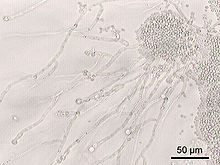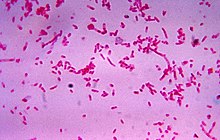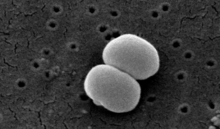List of microbiota species of the lower reproductive tract of women

This is the list of healthy
pathogens that can be found in the lower and upper reproductive tract of women can be found in the article sexually transmitted infection. The organisms listed below are capable of causing illness if for some reason there is a change in vaginal pH or a change in the ratio of one organism to another. For example, Candida is a normal inhabitant of a healthy reproductive tract but an overgrowth of this organism can cause candidiasis.[2][3][4]
Normal microbiota

This is the list of the normal flora that are found in the lower reproductive tract of
genetic component.[3]
Anaerobes




Aerobes
These bacteria may be detected as transients or are marginally discernable with PCR techniques. They are also opportunistic pathogens and their overgrowth is considered an infection though symptoms and signs may be absent.

| Genus | species | Gram stain | form | reference |
|---|---|---|---|---|
| Staphylococcus | aureus | + | cocci | [2] |
| Staphylococcus | epidermidis | + | cocci | [2] |
Group B Streptococcus |
spp. | + | cocci | [2][7] |
| Enterococcus faecalis | spp. | + | cocci | [2] |
| Staphylococcus | spp. | + | cocci | [2] |
| Actinomyces | israelii | + | bacillus | [2] |
Actinomyces |
neuii | + | bacillus | [1] |
| Escherichia | coli | - | bacillus | [2] |
| Klebsiella | spp. | - | bacillus | [2] |
| Proteus | spp. | - | bacillus | [2] |
| Enterobacter | spp. | - | bacillus | [2] |
| Acinetobacter | spp. | - | bacillus | [2] |
| Citrobacter | spp. | - | bacillus | [2] |
| Pseudomonas | spp. | - | bacillus | [2] |
While the vaginal microbiota is populated predominantly by Lactobacillus spp. in 71% of women, 29% of asymptomatic, healthy women possess a microbiota essentially lacking in Lactobacillus and instead the following groups have been isolated from this population. This microbiota is affiliated with ethnicity:
| Genus | species | Gram stain | form | reference |
|---|---|---|---|---|
| Aerococcus | spp. | cocci | [3] | |
| Atopobium | spp. | bacillus | [3] | |
| Dialister | spp. | bacillus | [3] | |
| Eggerthella | spp. | bacillus | [3] | |
| Finegoldia | spp. | [3] | ||
| Gardnerella | spp. | coccobacilli | [3] | |
| Megasphaera | spp. | [3] | ||
| Mobiluncus | spp. | bacillus | [3] | |
| Peptoniphilus | spp. | [3] | ||
| Prevotella | spp. | [3] | ||
| Sneathia | spp. | [3] |
Yeast

Candida albicans and other spp.[2]
Microbiota changes
postmenopausal women restores the microbiota to that of a reproductive-aged woman. The microbiota populations change in response to the menstrual cycle. Pregnancy alters the microbiota, with a reduction in species/genus diversity.[3]
Overgrowth of Candida albicans or other Candida (yeast infections) sometimes occurs after antibiotic therapy.[2] Bacterial vaginosis results in altered populations and ratios of the normal microbiota.[10][3][11]
There has been no link demonstrated between taking oral probiotics and maintaining normal microbiota populations of lactobacilli.[4]
References
- ^ PMID 25859220.
- ^ ISBN 978-0071716727.
- ^ PMID 24390920.
- ^ PMID 19821358.
- ^ PMID 24048183.
- PMID 21251190.
- ^ ISBN 9781455748013; Access provided by the University of Pittsburgh)
{{cite book}}: CS1 maint: postscript (link - ^ PMID 22719832.
- ^ PMID 24859749.
- PMID 29396486.
- PMID 22133886.
Further reading
- Bacterial vaginosis: a review on clinical trials with probiotics (2013)
- Enhanced Trapping of HIV-1 by Human Cervicovaginal Mucus Is Associated with Lactobacillus crispatus-Dominant Microbiota (2015)
External links
Wikispecies has information related to Microbiota.

- Aagaard K, Riehle K, Ma J, Segata N, Mistretta TA, Coarfa C, Raza S, Rosenbaum S, Van den Veyver I, Milosavljevic A, Gevers D, Huttenhower C, Petrosino J, Versalovic J (2012). "A metagenomic approach to characterization of the vaginal microbiome signature in pregnancy". PLOS ONE. 7 (6): e36466. PMID 22719832.)
{{cite journal}}: CS1 maint: multiple names: authors list (link - CDC
- NIH/Medline
- Pelvic Inflammatory Disease (PID; Salpingitis, Endometritis)
